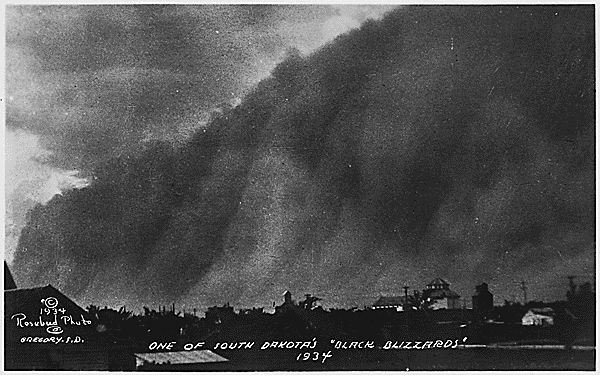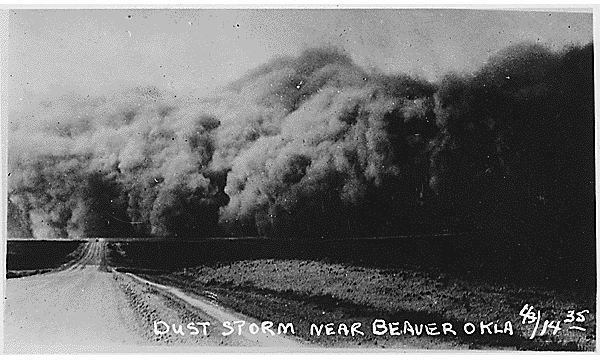Discovering the Dust Bowl: Facts and Timeline of This Devastating Time Period
When and Where Was the Dust Bowl?
There are several different opinions as to what actually constitutes the “dust bowl” era. Some people choose to use the date of the first sand storm (1931) as the start date while others use the first year of the drought (1930) and still others confine it to the actual drought years of 1934, 1936, 1939 and 1940. The U.S. Department of Agriculture starts the timeline for the dust bowl in 1930 and ends it in 1940 so this will be our definitive choice.
Dust Bowl Timeline
1931 – The first of several years of severe drought hits the wheat fields of the Great Plains. Dust storms rage stripping the topsoil from farms and destroying crops.
1932 – 14 dust storms are reported this year. The rain is sparse and doesn’t support crop growth.
1933 – Franklin Roosevelt takes office. One of his first acts is to work on the Emergency Banking Act of 1933 to stabilize the banking industry. The Emergency Farm Mortgage Act and Farm Credit Act of 1933 help thousands of farmers keep their farms out of foreclosure.
1934 – 75% of the country sees the effects of dust storms with severe storms dropping red snow on New England. The Frazier-Lemke Farm Bankruptcy Act and Taylor Grazing Act become cornerstones of the “New Deal” that keeps farmers afloat and adds feeding areas for livestock.
1935 – The Drought Relief Service (DRS) is established and one of their first acts is to buy cattle from farmers at $14-$20 a head (about 50% above market price). The Emergency Relief Appropriation Act is approved. This Act allows the creation of the Works Progress Administration that results in the employment of 8.5 million displaced workers. Farmers begin to be paid to practice soil-conserving farming techniques. This year also sees the worst dust storms ever on April 14th (Black Sunday).
1936 – The civil liberty union sues Los Angeles for sending 125 police officers to the Arizona and Oregon borders to keep “undesirables” out of the city.
1937 – FDR advocates the “ShelterBelt” program to plant a one hundred mile wide belt of trees from the Canadian border to Texas to keep the soil from erosion. Funding was an issue and this project showed limited success.
1938 – The efforts to rehabilitate the soil in the dust bowl region start to show promise as 65% less dust storm activity is recorded.
1939 – This is the last year of the drought and with the new farming methods and introduction of native trees, farming begins to come back into its own.
The dust bowl region consisted mainly of the panhandles of Oklahoma and Texas, central and western Kansas and eastern Colorado, although the drought was felt from Saskatchewan all the way to southern Texas. These areas were hit so hard by the drought and dust storms that often entire towns were wiped out in a matter of hours. Those that were not entirely destroyed were waylaid beneath feet of displaced topsoil.
Meteorological and Human Causes

The “dirty thirties,” as they were known at the time, were caused by a combination of human farming activity and a temporary change in weather patterns. When the settlers first started farming the land of the Great Plains they didn’t practice soil conservation. They clear cut and plowed all of the native trees and grasses that held the topsoil of the Plains intact.
With the successive years of planting, the topsoil began to dry out and when no rain came, with no deep rooted vegetation to hold it together, the topsoil became dust in the wind. At the onset of the Great Depression, prices that farmers could get for wheat rose sharply causing a glut of new farming in the Great Plains region.
This additional farming, using the standard clear cutting methods, added approximately 20 million acres to the farming region (butting it up against nationally protected lands). For a couple of years everything was looking good, but then the weather changed.
A recent computer simulation run by NASA based on weather patterns over the last 100 years came with a startling revelation about the meteorological component of the dust bowl and the unique weather patterns from 1931 to 1939. The simulation determined that “cooler than normal" tropical Pacific Ocean temperatures and warmer than normal tropical Atlantic Ocean temperatures contributed to a weakened low-level jet stream and changed its course.”
The changing of the course of the jet stream left the moisture laden clouds south of the Great Plains. Instead of traveling westward across the Gulf of Mexico and then north up into the Great Plains, the jet stream ran along the coast of Brazil and upwards into central Mexico. The lack of rainfall also led to drier soil conditions which meant less evaporation, leading to even less precipitation, creating a feedback loop that reinforces the lack of rainfall. The dust storms that result from this drought are some of the most iconic images of the time.
Weather Anomalies
Some of the most interesting dust bowl facts involve the immensity of the dust clouds and storms that raged through the Great Plains. In some cases, they reached cities as far away as Boston, which is often lost on those of us studying it today. The dust storms were referred to as “Black Blizzards” or “Black Rollers” because they would black out the sun and leave midday looking like midnight. The high winds in these dust storms could lift soil hundreds of feet in the air and drive it hundreds of miles over the plains.
Although black blizzards were an anomaly, they weren’t unheard of. Often when there was a time of low precipitation and high wind there were small dust storms. These would normally be confined to a few acres and result in one farmer having a drift of dirt to contend with. The difference in the 1930s was that the rain never came back and these storms got so large that they enveloped whole towns and stretched for miles on end. The dust storms grew so terrible in late 1934 and early 1935 that red snow fell on several parts of New England.
During the worst of the storms from 1933 to 1936, people in the region often had to shovel feet of sand out of their homes. Sometimes the storms were so bad that they would have to climb out of their windows so they could clear the sand from the front of their doors. The April 14, 1935 “Black Sunday” storms (20 confirmed) turned day to night almost instantly as 40 to 100 mph winds uprooted 300,000 tons of topsoil and turned it into a wall of sand that caused massive devastation throughout the southern Great Plains. This was the event that prompted a Lubbock report to coin the term “Dust Bowl” for the region, a name that stuck.
Population Migration

With farms unable to produce, many families were forced to give up their homes and migrate to new areas of the country. These displaced workers, known as “Okies” because the majority hailed from Oklahoma, found little acceptance wherever they went. Several of them tried their luck out west with over 200,000 people relocating to California only to find that economic conditions there were no better than where they came from. The Great Depression had driven unemployment rates up to nearly 20 percent in areas near Los Angeles. The immigration problem was so bad that at one point, in 1936, the LAPD sent 125 officers to the borders of Oregon and Arizona to keep new families from entering.
The mass exodus from the dust bowl region was estimated to be about 2.5 million people making it the largest single migration in the history of the United States. This migration caused a backlash against the “Okies” and many of them ended up living in unsanitary tar paper shacks with little to no plumbing.
Due to the poor record keeping of the time, no one knows the exact number of deaths that were caused by the dust bowl. The most oft quoted number is 7,000, although the number could be much higher. Further, more deaths were causede over time as a result of the relocation, dust pneumonia, malnutrition, or long-term health complications.
References
NASA Explains “Dust Bowl” Drought, https://www.nasa.gov/centers/goddard/news/topstory/2004/0319dustbowl.html
About the Dust Bowl, https://www.english.illinois.edu/maps/depression/dustbowl.htm
Economic History Association; The Dust Bowl, https://eh.net/encyclopedia/article/Cunfer.DustBowl
History in Motion 1936 Dust Bowl, https://www.eyewitnesstohistory.com/himdustbowl.htm
The “Black Sunday” Dust Storm of 14 April 1935, https://www.srh.noaa.gov/oun/?n=blacksunday
Image of “Dust Storm Approaching Beaver Oklahoma” courtesy of the Franklin D. Roosevelt Library, National Archives and Records Administration, https://docs.fdrlibrary.marist.edu/images/photodb/27-0721a.gif
Image of “One of South Dakota’s ‘Black Blzzards’” courtesy of the Franklin D. Roosevelt Library, National Archives and Records Administration, https://docs.fdrlibrary.marist.edu/images/photodb/27-0728a.gif
Image of “Young Oklahoma mother; age 18, penniless, stranded in Imperial Valley, Callifornia”, courtesy of the Franklin D. Roosevelt Library, National Archives and Records Administration, https://docs.fdrlibrary.marist.edu/images/photodb/27-0674a.gif
